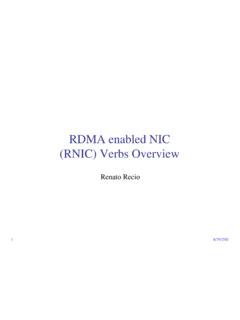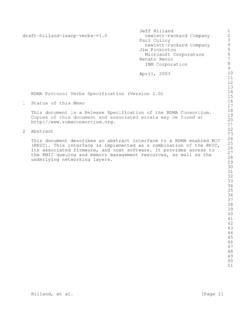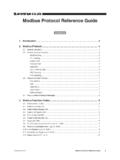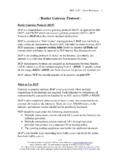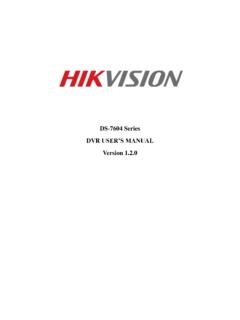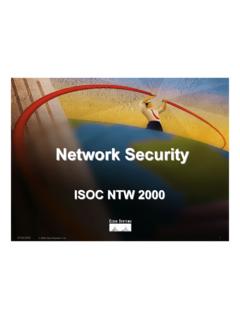Transcription of Sockets Direct Protocol v1.0 RDMA Consortium
1 Sockets Direct Protocol RDMA Consortium Jim Pinkerton RDMA Consortium 10/24/2003. Agenda ! Problems with existing network Protocol stacks ! Sockets Direct Protocol (SDP). Overview Protocol details ! Connection setup, including SDP Port Mapper ! Data transfer mechanisms ! Modes ! Buffering issues ! Comparing SDP on iWARP to SDP on InfiniBand 2. Problems with Existing Protocol Stacks ! Excessive CPU utilization ! Memory-to-memory copying of data ! User context switches All Contribute to: ! User/kernel transitions Decreased I/O Operations per second ! Interrupts Increased Latency ! Protocol overhead Decreased Bandwidth ! Excessive memory bandwidth utilization ! Copying of data triples or quadruples memory bandwidth requirements. Data is moved into intermediate memory buffers from the network, then copied to the final buffer ( moved to the CPU, and then moved back to a new memory location) for a total of 3x bandwidth.
2 Often memory coherency traffic can effectively cause a total of 4x bandwidth consumption. 3. SDP Highlights ! Enable RDMA optimized transfers while maintaining traditional socket stream semantics ! SDP Port Mapper enables SDP to integrate with existing TCP port namespace ! SDP over iWARP can cross multiple subnets ! RDMA Consortium SDP requires iWARP RDMA. ! Protocol offload ! Reliable, in-order delivery in hardware ! NIC demultiplexes data stream instead of OS. ! No copying of data when appropriate ! Use of RDMA Reads and Writes enables Direct data placement into application buffer ! Architectural optimizations ! Kernel bypass, Interrupt avoidance ! Based on an existing Protocol ! In commercial use, field proven, shipping on existing RDMA networks today ! Compatible with SDP on InfiniBand 4. SDP Focus ! Map byte-stream Protocol to iWARP's RDMA Write, RDMA.
3 Read, and Send transfers Sockets is the dominant API for networking programming (traditionally used for TCP/IP). ! Socket stream semantics SOCK_STREAM w/ TCP error semantics, same TCP port range Graceful & abortive close, including half closed Sockets IPv4 or IPv6 address resolution Out-of-Band data, socket options Socket duplication ! SDP Optimizations Transaction oriented applications Mixing of small and large messages 5. Example SDP Architectural Model Traditional Model Possible SDP Model SDP. OS Modules Socket App Socket Application NIC. Sockets API Sockets API. Hardware Sockets User TCP/IP/ Sockets User TCP/IP/ Sockets Sockets Direct Kernel Provider Kernel Provider Protocol TCP/IP Transport TCP/IP Transport Driver Kernel Driver Bypass Driver Driver RDMA. Semantics NIC NIC. 6. SDP Terminology Connecting Peer The side of the connection which initiated connection setup.
4 Accepting Peer The side of connection which received the connection setup request. Data Source The side of connection which is sourcing the ULP data to be transferred. Data Sink The side of connection which is receiving (sinking) the ULP data. Data Transfer Mechanism The mechanism to move ULP data from the Data Source to the Data Sink (Bcopy, Write Zcopy, Read Zcopy, and Transactions). Flow Control Mode The state that the half connection is currently in (Combined, Pipelined, or Buffered). Constrains which Data Transfer Mechanisms can be used. Bcopy Threshold If the message length is under a threshold, use 7. the Bcopy mechanism. The threshold is locally defined. SDP Buffering Model SDP SDP. Private Buffer Private Buffer Buffer Pool Pool Buffer Copy Fixed Copy Path Size Path Data Data Sink Source ULP. ULP. Buffer Buffer iWARP. Zero RNIC RNIC. Zero Copy Path Copy Path !
5 Enable buffer-copy path when Transfer is short Overhead associated with pinning the ULP buffer in memory, advertising the buffer to the remote Peer, and then transferring the data is higher than simply copying the data into the send SDP Private Buffer Pool, sending it directly to the remote Peer's receive SDP Private Buffer Pool, and then copying it into the ULP buffer. Application needs buffering Some applications require the network to buffer the data for good performance. For example, if the application has many short transfers to perform, but only allows one transfer to be outstanding at a time, it is usually more efficient to copy the transfers into a send buffer and return to the application immediately. The ULP data is transferred to the remote Peer at a later time. ! Enable zero-copy path when Transfer is long If the transfer is long, then the overhead to pin the ULP send and receive buffers in memory and exchange a steering tag to directly transfer the data between the ULP buffers is small compared to the cost of copying all the data into the SDP Private Buffer Pool.
6 8. SDP Port Mapper ! SDP Port Mapper enables re-use of the existing network service mapping infrastructure Continue to use existing mechanisms to map a service name to a TCP Port and IP address (referred to as the Conventional Address). SDP Port Mapper Protocol enables an SDP Connecting Peer to discover an SDP Address given a Conventional Address. An SDP. Address is a TCP Port and IP Address for the same service, but the SDP Address requires data to be transferred using SDP over RDMA. Connecting Peer uses the SDP Address to establish a TCP. connection. Connecting Peer uses SDP Hello Message to advertise startup parameters and then enables iWARP mode All further SDP communication uses iWARP. 9. Port Mapper Protocol Architecture Server Side Client Side Port Port Mapper Protocol Port Mapper Mapper Server The Connecting Peer uses the Port Client Mapper Protocol to decide whether the Accepting Peer wishes to use the Conventional TCP Address or use an SDP.
7 Address, talking the SDP Protocol . Connecting TCP. Accepting Peer Address ? Peer (Service). SDP. Address 10. SDP Port Mapper Protocol Client Side Server Side PM Client PMRequest It requests an SDP Address PM Server It verifies that the service for the Connecting Peer is available, and ensures PMAccept that an SDP Address (TCP. port and IP address ready PM Client notifies to talk SDP) is enabled. If Connecting Peer of the one is not, it will send back SDP Address, and sends a a PMDeny. PMAck PMAck to confirm the PMAccept Connecting Peer TCP SYN Depending on the result Accepting Peer from the PM Client, the The connection is accepted TCP SYN ACK Connecting Peer initiates a on either the SDP Address TCP connection to the SDP. or the Conventional Address or to the Address, depending on TCP ACK Conventional Address configuration 11. SDP Enables iWARP Mode Client Side Server Side Connecting Peer a ge In streaming mode, the M e ss Accepting Peer Hello mode Connecting Peer a mi ng Accepting Peer verifies SDP stre advertises SDP and IWARP.
8 And iWARP parameters in parameters to the Hello Message, and Accepting Peer, and initializes iWARP mode. immediately enables IWARP Mode. Once iWARP mode is initialized, an iWARP Send is used to send a HelloAck HelloA. ck Mes Message, which advertises iWARP sa ge to the Connecting Peer SDP mode and iWARP parameters. HelloAck is received, parameter exchange is SDP Data transfer can be complete, SDP data initiated immediately. transfer can be initiated immediately. Streaming mode is conventional TCP/IP data transfer iWARP mode requires iWARP over TCP/IP. 12. SDP Data Transfer Mechanisms ! Bcopy - Transfer of ULP data from send buffers into receive Private Buffers. ! Read Zcopy - Transfer of ULP data through RDMA Reads, preferably directly from ULP Buffers into ULP Buffers. ! Write Zcopy - Transfer of ULP data through RDMA Writes, preferably directly from ULP Buffers into ULP Buffers.
9 ! Transaction - An optimized ULP data transfer model for transactions. It piggy-backs ULP data transfer using Private Buffers on top of the Write Zcopy mechanism used to transfer ULP data on the opposite half-connection. 13. SDP Data Transfer Mechanisms: Bcopy Data Source Data Sink Send of data Data Msg w/ data in buffer size chunks Data Msg w/ data Receive data in buffer size Data Msg w/ data chunks Data Msg w/ data Data Msg Flow control update w/o data is piggybacked on Gratuitous credit reverse channel update may need traffic to be sent if no Required msg SDP messages sent in Optional msg reverse direction 14. Data Transfer Mechanisms: Read Zcopy Data Source Data Sink Data Source SrcAvail exposes buffer (may contain data). Data Sink retrieves buffer RDMA Read Data Sink RdmaRdCompl notifies Data Source of RDMA. Data Source completion may deregister buffer Advantage: One less operation at Data Source.
10 15. Data Transfer Mechanisms: Write Zcopy Data Source Data Sink Src optionally tells SrcAvail Sink exposes Rx Write is available buffer SinkAvail Src cancels SrcAvail, Uses Write Zcopy Src sends data RDMA Write Src sends header Sink receives data RdmaWrCompl Sink receives header for data 16. Data Transfer Mechanisms: Transactions Data Transaction SDP Data Transfer Command Data Msg w/ data SDP SinkAvail Reply RDMA Write Notes: RdmaWrCompl " Typically short commands, medium to long replies " Typical Transfer Mechanisms SDP Transaction " Command bcopy SinkAvail w/ data " Reply bcopy or zcopy " Transaction Transfer Enables RDMA Write " Fewer messages RdmaWrCompl " Lower threshold for zcopy 17. Data Transfer Mechanisms: Forcing use of Bcopy Data Source Data Sink Src tells Sink write is available SrcAvail Sink notifies Src to use bcopy SendSm mechanism Src sends data using bcopy Data Msg w/ Data mechanism Data Msg w/ Data Sink receives data Data Msg w/o Data Optional Src updates flow control flow control update 18.
